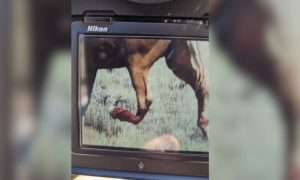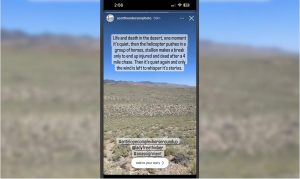Less than a week into a massive federal helicopter roundup in Nevada, six wild horses are dead, including from a snapped neck and a horrifically fractured leg, while others have tragically been separated from their herd families, as documented by a Lady Freethinker observer.
The federal Bureau of Land Management (BLM) on Sunday started two simultaneous roundups using helicopters to push panicked wild horses toward corrals, with an aim to remove more than 3,000 of the iconic animals from the Antelope Complex — a tract of public and private lands spanning nearly 400,000 acres that the agency has split into “North” and “South” operation bases.
Lady Freethinker sent an observer during the first week of the roundup to the North area, where the observer immediately reported excessive heat — with temperatures nearing or topping 90 degrees on several days — and wind speeds so high that the BLM actually had to cancel one of their planned gather days.
The third day our observer was there, three horses were killed — including a spirited Palomino stallion who broke his leg while escaping from the corral and who then was pursued by wranglers, for almost an hour, over an estimated four miles before he was shot to death.
Although the BLM had stationed our observer more than a mile from the trap site, the observer used a long lens to zoom in and capture the cruelty after noticing the stallion trying to escape.
The photographs show a bloody back leg, bent unnaturally to the front, as the stallion escaped, hesitated to leave his herd behind, and then fled.
“He jumped out of the trap, stumbled a little bit, then stopped and looked back toward the other horses,” the observer said. “He would run, stop, look back. Then he ran.”

(Scott Henderson/Lady Freethinker Investigation)
The observer used GPS coordinates to track the stallion’s flight, reporting the stallion covered nearly a mile before wranglers gave chase.
Even though he was severely injured, the stallion tried to take the high ground, pushing up a ridge and blowing past a wrangler who tried to rope him.
The helicopter then maneuvered toward the top of the draw, pushing the stallion down toward the wranglers.
But the stallion outsmarted that attempt and ran west for another reported third of a mile, where he and the wranglers dropped below the sight of the observer.
A gunshot followed, along with a fatality report from the BLM that a stallion had been “humanely euthanized” following a gather-related, compound break in his left rear leg.
LFT’s observer started timing the chase at 9:39 a.m. Pacific Standard Time and heard the gunshot at 10:29 a.m. — meaning the stallion spent the last 50 minutes on earth separated from his herd, severely injured, and running for his life through high heat and hilly terrain.
Two female foals also were killed Thursday, with the BLM reporting the causes of deaths as colic and lameness with severe infection that existed prior to the roundup.
Even on the days no horses were injured or killed, the observer noted the sound of the helicopter was deafening compared to the silence to which the horses likely are accustomed.

(Scott Henderson via Instagram)
Tragically, Antelope Complex-South also has seen three deaths, including a 4-year-old mare who died after breaking her neck on the first day of the gather and two foals, who were killed reportedly for colic and dehydration caused by diarrhea.
Daily gather reports also reference a stallion from the South side “released” after he “jumped out of holding” at the temporary corral.
As of Thursday, the BLM reported gathering 593 horses — 200 stallions, 270 mares, and 123 foals — between the two gathers. At that current fatality rate, by the time the BLM reaches its gathering “goal” a projected 31 total horses could be dead.
As a comparison, the last time the BLM conducted a gather in the Antelope Complex — which gathered 2,203 wild horses in 2021 — 11 horses died, including three stallions and a mare who died “suddenly” from gather-related injuries.
The BLM did not immediately respond to media inquiries regarding the escaped stallions, the potential for preventable injury resulting from fences that terrified and spirited wild animals can jump, or the high number of deaths in the first week of the gather.
But on its website for the North area of the complex, the agency said the roundup was necessary due to “extremely limited forage and water resources” and to “prevent undue and unnecessary degradation to public lands associated with excess wild horses.”
The BLM reported 6,852 wild horses currently in the Northern range and a desired drop off to 285 to 465 wild horses.
“We conduct gathers like this to ensure that rangeland and wild horse health are not at risk due to herd overpopulation,” Gerald Dixon, the Elko District manager, said in a public posting. “We are committed to conducting safe and humane gather operations as we work to protect animal health by bringing herd size down to [an] AML in order to help restore a thriving natural ecological balance on the range.”
Meanwhile, the body condition scores of the horses gathered from the North range all were reported as 3 to 4 — designating the horses were “thin” or “moderately thin” but which is typical of wild horses at the start of summer.
Official documents for the entire Antelope Complex also note 31 total grazing allotments for livestock — including cattle, sheep, and goats — spanning at least 124,931 Animal Unit Months (AUM). An AUM can roughly be defined as the amount of forage needed for 1,000 pounds of animal — typically a mother cow and her calf, five sheep, or five goats.
Those grazing allotments will continue to be authorized even as iconic wild horses are injured, killed, separated from their families, and shipped hundreds of miles away to live out their lives, often in limbo.
As of June, more than 59,000 wild horses gathered during past roundups were still in temporary holding nationwide, according to the BLM.
The captured horses from the Antelope Complex’s North end will be shipped to the Indian Lakes facility in Fallon, Nevada, from which they’ll be sent to off-range pastures or put up for adoption through the Adoption Incentive Program — a program notoriously known to offload wild horses to kill buyers and individuals with past connections to horse slaughter, according to recent news exposés.
The BLM itself has noted its current methods are unsustainable, noting “the public’s demand for adoptable wild horses has declined sharply over the last 10 years, leaving the federal agency in the unsustainable position of gathering excess horses while its holding costs spiral upward.”
It’s time for change.
The two roundups currently are scheduled through August 22. We’ll keep watching the situation in Nevada and advocating for these precious wild horses. In the meantime, we also have sent a letter to authorities asking for an immediate termination of the Antelope Complex roundup.
You can read more about LFT’s observations at last year’s Triple B Complex roundup — in which 23 horses, including five foals, were killed, including for fractured legs and broken necks — here.
You can read more about LFT’s observer’s experience on the range here.
You can also help stop the cruelty by signing our petition urging legislators and the BLM to ban these cruel helicopter roundups — which have always led to brutal deaths, injuries, and family separations — and prioritize more compassionate alternatives, including humane vaccines that would address cited population concerns while allowing wild horses to remain in their wild homes.
SIGN: Stop Cruel Helicopter Roundups That Are Killing Wild Horses








